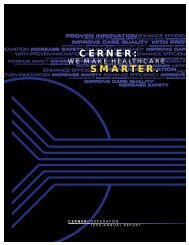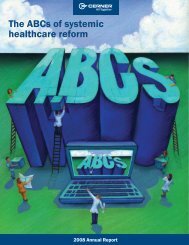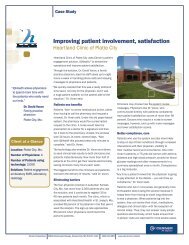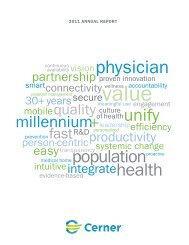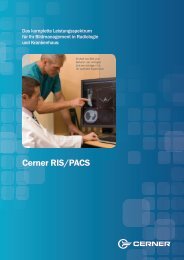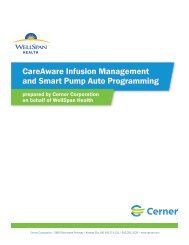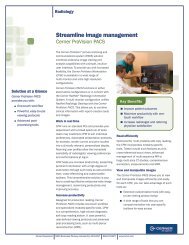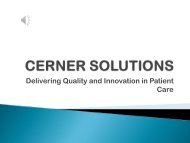Download the Full Report - Cerner Corporation
Download the Full Report - Cerner Corporation
Download the Full Report - Cerner Corporation
You also want an ePaper? Increase the reach of your titles
YUMPU automatically turns print PDFs into web optimized ePapers that Google loves.
MANAGEMENT’S DISCUSSION AND ANALYSIS OF FINANCIAL CONDITION AND RESULTS OF OPERATIONS<br />
Following an inspection by <strong>the</strong> FDA in March of 1998, <strong>the</strong> Company received a two-item Form FDA 483 (Notice of<br />
Inspectional Observations) containing observations of non-compliance with <strong>the</strong> Federal Food, Drug and Cosmetic Act (<strong>the</strong> Act)<br />
with respect to <strong>the</strong> Company’s PathNet HNA Blood Bank Transfusion and Donor products (<strong>the</strong> Blood Bank Products). The<br />
Company subsequently received a Warning Letter, dated April 29, 1998, as a result of <strong>the</strong> same inspection. The Company<br />
responded promptly to <strong>the</strong> FDA and undertook a number of actions in response to <strong>the</strong> Form 483 and Warning Letter, including<br />
an audit by a third party of <strong>the</strong> Company’s Blood Bank Products. A copy of <strong>the</strong> third party audit was submitted to <strong>the</strong> FDA in<br />
October of 1998 and, at <strong>the</strong> request of <strong>the</strong> FDA, additional information and clarification was submitted to <strong>the</strong> FDA in January<br />
of 1999.<br />
There can be no assurance, however, that <strong>the</strong> Company’s actions taken in response to <strong>the</strong> Form 483 and Warning Letter will be<br />
deemed adequate by <strong>the</strong> FDA or that additional actions on behalf of <strong>the</strong> Company will not be required. In addition, <strong>the</strong><br />
Company remains subject to periodic inspections and <strong>the</strong>re can be no assurances that <strong>the</strong> Company will not be required to<br />
undertake additional actions to comply with <strong>the</strong> Act and any o<strong>the</strong>r applicable regulatory requirements. Any failure by <strong>the</strong><br />
Company to comply with <strong>the</strong> Act and any o<strong>the</strong>r applicable regulatory requirements could have a material adverse effect on <strong>the</strong><br />
Company’s ability to continue to manufacture and distribute its products, and in more serious cases, could result in seizure,<br />
recall, injunction and/or civil fines. Any of <strong>the</strong> foregoing would have a material adverse effect on <strong>the</strong> Company’s business,<br />
results of operations or financial condition.<br />
Product Related Liabilities – Many of <strong>the</strong> Company’s products provide data for use by healthcare providers in providing care to<br />
patients. Although no such claims have been brought against <strong>the</strong> Company to date regarding injuries related to <strong>the</strong> use of its<br />
products, such claims may be made in <strong>the</strong> future. Although <strong>the</strong> Company maintains product liability insurance coverage in an<br />
amount that it believes is sufficient for its business, <strong>the</strong>re can be no assurance that such coverage will prove to be adequate or<br />
that such coverage will continue to remain available on acceptable terms, if at all. A successful claim brought against <strong>the</strong><br />
Company which is uninsured or under-insured could materially harm its business, results of operations or financial condition.<br />
Year 2000 – The following statements are a “Year 2000 Readiness Disclosure” within <strong>the</strong> meaning of <strong>the</strong> Year 2000<br />
Information and Readiness Disclosure Act. Computer programs that use two digits to identify a year may fail or create errors in<br />
<strong>the</strong> year 2000, leading to system failures or miscalculations causing disruptions to <strong>the</strong> operations of <strong>the</strong> user. The Company has<br />
conducted a Year 2000 review of its operations focusing on <strong>the</strong> Company’s products and <strong>the</strong>ir use by its clients, <strong>the</strong> computers,<br />
operating systems and data bases used in conjunction with its products and <strong>the</strong> Company’s internal operations.<br />
The Company’s software products currently being marketed are Year 2000 compliant. The costs incurred to make <strong>the</strong><br />
Company’s current versions compliant have occurred in <strong>the</strong> ordinary course of software development and enhancement and<br />
have not been material. All of <strong>the</strong> Company’s clients using older versions of its software products are entitled to upgrade to <strong>the</strong><br />
compliant versions with no charge for <strong>the</strong> compliant version. However, some have elected not to do so for a variety of reasons.<br />
The Company is working with <strong>the</strong> clients who wish to upgrade to address Year 2000 issues. These clients have ei<strong>the</strong>r been<br />
upgraded to compliant versions or are scheduled to be upgraded to compliant versions of <strong>the</strong> Company’s software by August<br />
1999. The Company is assisting those clients to upgrade using electronic access from <strong>the</strong> Company’s facilities without charge.<br />
If <strong>the</strong> client desires on-site assistance, <strong>the</strong> Company is assessing its normal charges. These services are being conducted in <strong>the</strong><br />
ordinary course of <strong>the</strong> Company’s business by its employees, and <strong>the</strong> costs to <strong>the</strong> Company are not expected to be material.<br />
The Company is also engaged in many projects to implement its products at client sites. These projects require efforts both by<br />
<strong>the</strong> Company and its clients. For some of <strong>the</strong>se clients, <strong>the</strong>se projects constitute <strong>the</strong>ir solution to Year 2000 issues.<br />
Substantially all of <strong>the</strong>se projects are planned to be completed by September 1999. The Company is working with its clients, or<br />
<strong>the</strong> clients are working independently, on contingency plans for Year 2000 issues where <strong>the</strong>re is a reasonable likelihood <strong>the</strong><br />
project may not be completed by <strong>the</strong> end of 1999.<br />
As clients and potential customers focus on efforts to update <strong>the</strong>ir current systems, <strong>the</strong>y may elect to delay capital investments<br />
in information systems in order to focus <strong>the</strong>ir capital budgets on <strong>the</strong> expenditures necessary to bring <strong>the</strong>ir existing systems into<br />
Year 2000 compliance. As a result, <strong>the</strong> Company may not achieve expected sales revenues and its business, financial condition<br />
and results of operations could be materially adversely affected.<br />
The Company believes that its internal third-party software applications, operating systems and telephone systems are Year<br />
2000 compliant. The Company did have some internally developed software applications that required upgrading to be Year<br />
2000 compliant. These upgrades were done internally and have been completed. The Company has also replaced some older<br />
computers and operating systems that were not Year 2000 compliant in <strong>the</strong> normal course of infrastructure maintenance.<br />
C ERNER<br />
CORPORATION<br />
ANNUAL R EPORT 21



